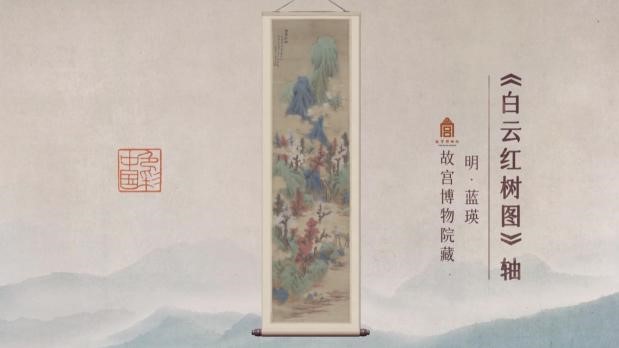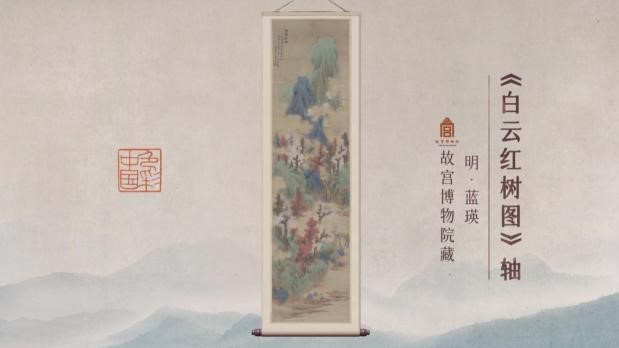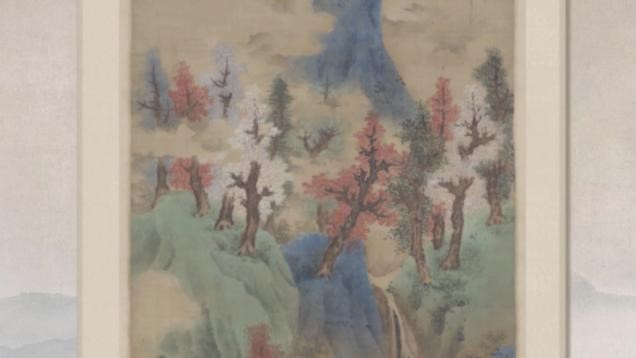Lan Ying (ca.1585-1664) was a renowned painter of the Ming dynasty (1368-1644) whose genius lay in landscape paintings, among which "White Clouds and Red Trees" was a pinnacle work. The masterpiece is heavy-colored, combining a variety of brilliant colors such as green, blue, red and white. The mountains and stones in the painting were not outlined, but were directly rendered with pigments. The over-elaborate color palette makes a tremendous visual impact. Instead of directly drawing from life, the painting was an original artwork created from Lan Ying's imagination, showing his remarkable innovations in style, brushwork and artistic conception. Produced by China Media Group, the cultural program "China in Poetry and Painting" has invited famous dancer Xie Xin and her partners to present the scene depicted in the painting, offering a kaleidoscope of colors on the show's stage.
05:50

"White Clouds and Red Trees" is typical of Lan Ying's later works, now housed in the Palace Museum in Beijing. The most prominent characteristic of the painting is the use of color, which is different from that of other Chinese landscape paintings — most of the time preferring plain colors mixed by thinned ink. The color palette of the painting is so bright and vibrant that some people regard it as the "king of color" among Chinese paintings. In this masterpiece, Lan Ying presented the mountains and rocks primarily in blue and green. He applied vermilion to paint the small grasses, and the leaves were highlighted in dense red, yellow, blue and green. The clouds are rendered with white powder, looking as if they were floating around the peaks of a rolling terrain. A flowing stream trickles down through the rocks, and a wooden bridge crossing the stream is hazy in the distance. In the forest, an old recluse is promenading alone. These scenes depicted by the painter jointly saturate the work with a feeling of vigor and poetic atmosphere.

"White Clouds and Red Trees" by Lan Ying /CGTN
"White Clouds and Red Trees" by Lan Ying /CGTN
In "White Clouds and Red Trees," pigments are used rather than ink to present an idyllic rural scene and leisurely pace of life, exuding a mellow, classical and elegant effect. According to Lou Wei, the deputy director of the Palace Museum, Lan Ying, who was born to a poor family, started to paint to make a living at an early age. At first, he imitated other paintings and studied the works of previous masters. While developing techniques through practicing, he gradually formed his own painting style on the basis of traditional painting. He later made friends with some renowned literati and travelled to many mountains and rivers. The experience inspired him to create a unique landscape painting style characterized by magnificence and vigor.

Details of "White Clouds and Red Trees" by Lan Ying /CGTN
Details of "White Clouds and Red Trees" by Lan Ying /CGTN
Throughout history, artists have produced works in a variety of forms and styles, and some of these convey matching philosophies and sentiments. On the stage of "China in Poetry and Painting," dancer Xie Xin and her partners bring the scenery depicted in the painting alive through their dance. In the beginning, Xie Xin huddles herself up like a seed in the soil. Accompanied by a peaceful and melodious tune, she stretches herself out, mimicking a seed sprouting. All of a sudden, Xie Xin — dressed in red silk — is transformed into a "red tree" through her dynamic dance moves. With leaves fluttering in the wind and mist filling the forest, the dancer moves as if she were a fallen red leaf picked up by the wind and blown away past mountains and rivers, engaging audiences in a strong sense of life force.

Xie Xin and her partners dance in red silk. /CGTN
Xie Xin and her partners dance in red silk. /CGTN
Traditional Chinese culture emphasizes the importance of unity between humans and nature, and regards humans as an integral part of nature. This is reflected in Taoist sage Laozi's philosophy which says that man is modeled on Earth, Earth on heaven, heaven on Tao, and Tao on nature. Whether in the form of painting, poetry or dance, countless Chinese artists are pursuing the message of harmony between humankind and nature in their works, which are like little boats on the sea of culture. They communicate, transcend and innovate on the voyage, steering towards spiritual enlightenment.